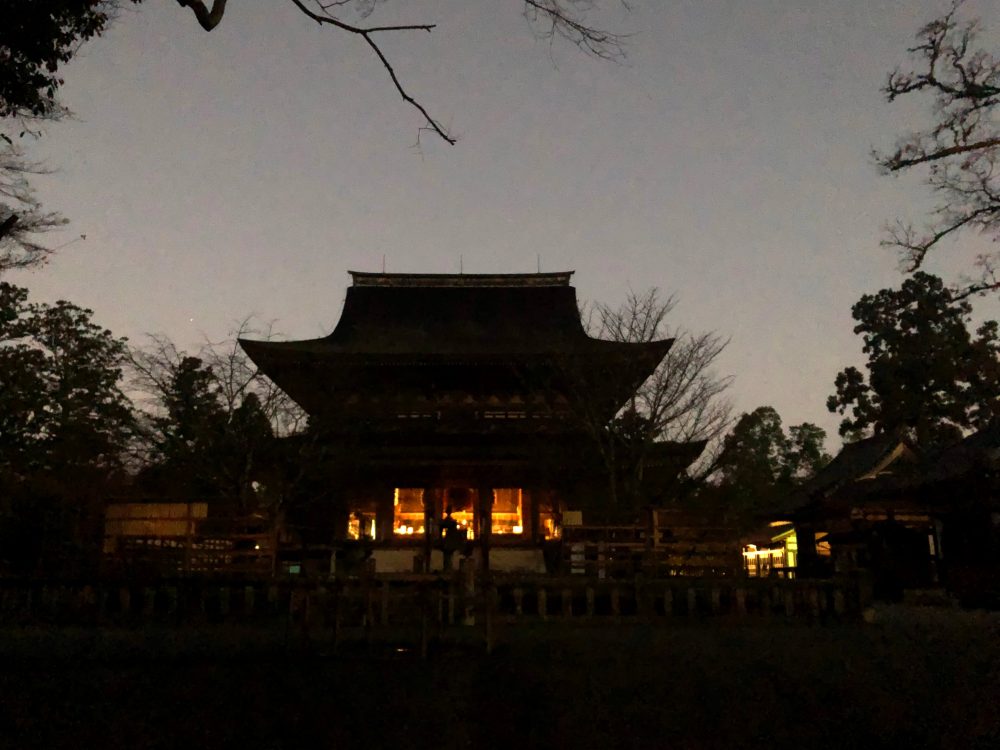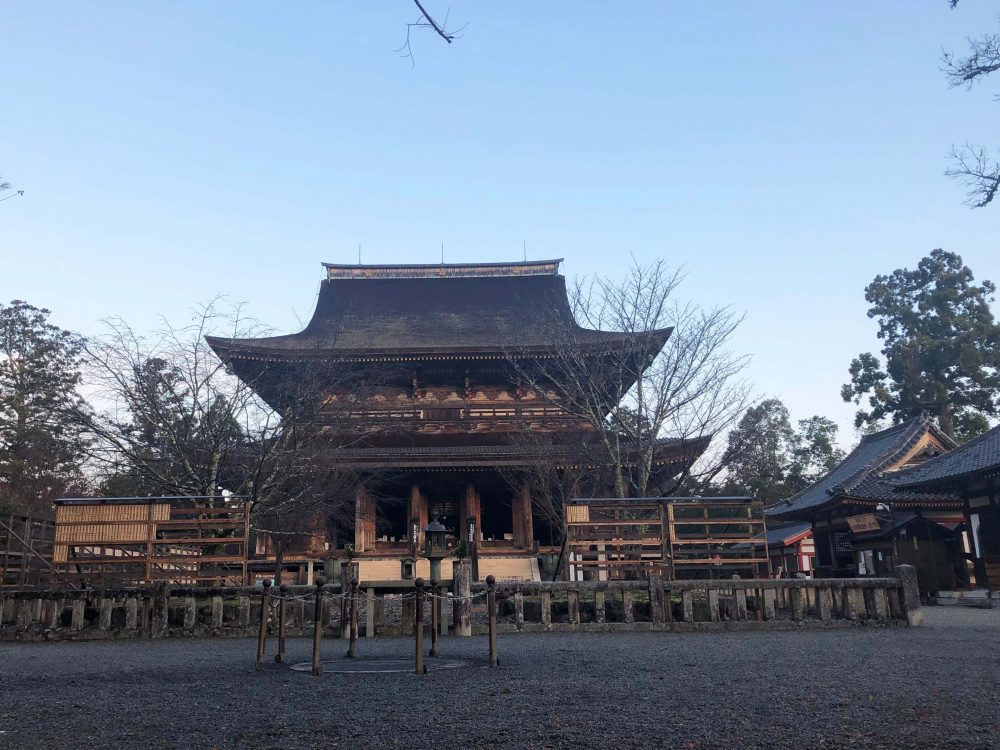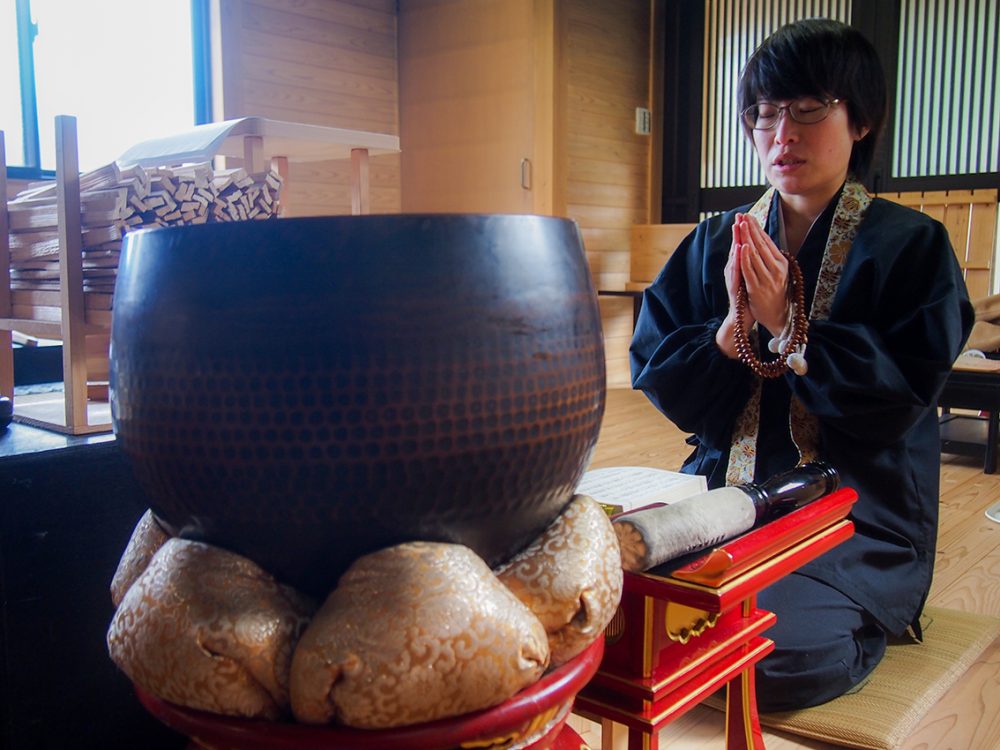Speaker: Fumie Katayama, Yamabushi
What is Yamabushi?
Before I came to Yoshino, I didn’t know that there was “Shugendo” in religions such as Shinto, Buddhism, Christianity, and so on… I didn’t know that Kinpusen-ji Temple is the grand head temple of Shugendo that everyone visits while walking in Mt. Yoshino.
It has been half a year since I moved to Nara and I have had some opportunities to meet with the priests of temples and shrines I had never met before. People I had no connection with prior to my arrival here. I also met the people known as “yamabushi” for the first time in Yoshino.
A yamabushi (or “Shugenja”) is a person who practices Shugendo. Their style may be familiar to local people, but for me, a person from outside of Nara, their appearance looks quite odd. They wear some kind of small hat on their head, animal fur on their waist, and they blow a conch shell horn. They are also known for doing extreme spiritual training in the mountains, but it seems like they also live everyday life like we do.
Seeking more knowledge and clarification about Shugendo, I talked to Fumie Katayama, a guesthouse manager to teach me about the world of yamabushi.

The dress of Yamabushi. Illustrated by Fumie Katayama.
Tokin hat
It represents the treasure crown of Dainichi Nyorai, who is said to be the deity to which the universe itself owes its existence. Wearing the tokin is like being with Dainichi Nyorai. It also protects your head from stones and other mountain hazards.
Hisshiki (thick material)
It is made of beast fur and imitates an animal carrying gods and Buddhas. Since Shugendo practitioners worship all nature as incarnations of the divine, the fur is also like an amulet. In terms of practicality, it is also a nice cushion when sitting on rocks. It is an excellent product that does not stain from water as well.
Horagai conch shell horn
Used like a signal horn, it also has the role of letting the mountain gods know that practitioners are entering into their realm. It furthermore acts as an amulet that dispels the evil of a place.

Ms. Katayama playing the horagai. You can see Kinpusen-ji Temple in the back left.
Ms. Katayama majored in science and is a Yambushi. She used to be a No. 1 ranked Taekwondo champion in Japan, has deep knowledge of “yokai (Japanese folk monsters)”, and is a guesthouse manager… Clearly, she is full of interesting elements other than being a yamabushi.
Three years ago, she jumped into the world of Shugendo.To become a Yamabushi, people need to do a special vow ritual to start their training.To give you a more familiar example, it may seem like commiting to a “marriage” of sorts. When people get married, they ask themselves if they really want to live their lives together, decide on it, and swear to do so. Actually, this is not the goal but just the beginning. After committing to being a yamabushi, the days of real training begin.
All Shugendo teachings are taught by oral communication between specific teachers and pupils. I’ve heard that the most important thing to do when you start something is to find a good teacher. That is also the most important thing for learning Shugendo. Once a yamabushi starts a teacher-pupil relationship, it means having a deeper bond than a couple, rather it is more like a parent-child situation. Even if you marry and swear to a life of love, you can still get divorced. However, the relationship between teacher and the pupil will basically last a lifetime. It is said that it will last not only in this world but also in the next life, so even if we were to reincarnate, this connection would be maintained.
In the relationship between the teacher and the pupil, “what the teacher says is absolute.” If the teacher says “YES,” even if the answer is “NO,” the pupil needs to say “YES!” While there are no such unreasonable requests between those who aspire to world peace, their connection is strong to that extent. In other words, they will establish a trusting relationship with each other with determination. They take care, teach, and learn from each other with greater responsibility than a family or a couple. It cannot be done without great love and respect. Therefore, “The hardest thing about getting into the world of Shugendo is meeting a good teacher,” says Ms. Katayama.
In summary, meet the one and only teacher, establish a teacher-pupil relationship, do a vow ritual to start training, and begin training for the rest of your life. From then on, they pray for the happiness of everyone (other than themselves) every day. Just hearing this alone made me feel great respect for yamabushi.
What kind of religion is Shugendo?
Shugendo is a Japanese ideology that developed in a unique way. Buddhism, Shintoism, Taoism, and other traditions were blended into mountain and nature worship. The sacred mountains of Shugendo can be found all around the country. It is also a faith that welcomes any person or denomination, which is very Japanese-like.Ms. Katayama taught me that “The act and thoughts of joining hands is more important than what is actually worshiped. So Shugendo accepts anyone and any denomination.”
In Christianity, Jesus Christ is enshrined, and in Buddhism, the Buddha who has a relationship with each temple is enshrined. In Shugendo, the deity “Kongo Zao Daigongen” is enshrined. “Kongo Zao Daigongen” is commonly referred to as “Gongen-sama” or “Zao-san,” and has a blue face, and looks a slightly scary appearance. In his right hand, he lifts up a tool called a “sankosho,” which is for breaking the earthly desires, and in his left hand, he makes a symbolic mudra near his waist, with his right leg raised up in the air. This characteristic pose seems to represent how he looked when he first appeared in our world.

In the difficult time of 1300 years ago when Buddhism was widespread, a smart young man (En-no-ozuno, the founder of Shugendo) prayed for a better world. As a result, Shakya Nyorai, Senju Kannon, and Miroku Bosatsu appeared before him (in this order). However, En-no-ozuno responded by saying, “The world cannot be saved with such a gentle appearance as you have. We need a more rigorous Buddha for this turbulent world!” and, as a result, Gongen-sama appeared.
By the way, the term “gon (権)” means “a temporary figure,” as it said that the three Buddhas who appeared earlier actually changed changed their appearance and returned, manifested as Gongen-sama.
As Gongen-sama is a temporary figure, he changes into various forms, such as other Buddhas, mountains, rivers, or people in front of us. That is why Yamabushi worship so many different things.
What is the life of a yamabushi like?
Like Ms. Katayama, who is working as a landlady, many Yamabushi have a life that is “half priest and half earthly.” This means living and working in the same way as ordinary people, although they are actually priests. This way of living also goes back to Shugendo’s founder, En-no-ozuno. They work every day like ordinary people and also do training!
When I think of training, I imagine climbing harsh mountains or standing under a waterfall (these are actually real forms of training). In addition to such training, one of the important things that they will continue to do throughout their lives is “Bodhisattva Practice.” This is to think and act in such a way that is most conducive for making everyone in the world happy in their daily lives. In a world where a wide variety of people and thoughts exist, “making everyone happy” is a difficult thing to accomplish, to say the least.
“Something might be good for this person, but what about that person…” It seems the more you think about it, the more questions come to mind. However, to always ask how to address difficult problems, do what you can, and keep thinking in such a manner is one part of Shugendo training.
First of all, you need to be aware. If you are not conscious of what you are doing you will not be able to ask important questions and observe your surroundings. It is important to observe deep inside yourself and the people around you.
I think making everyone happy is what everyone wants on a basic level; it is part of being human. In that regard, I feel that “Bodhisattva practice” should be practiced by everyone, even if you are not a yamabushi. If each and every one of us can act like a yamabushi, the world will be a gentler place.
The cherry blossoms of Yoshino and Shugendo

Yoshino is famous for its cherry blossoms and there is a great relationship between these flowers and Shugendo. When Gongen-sama first appeared, En-no-ozuno carved the image of the deity’s figure out of a cherry tree.
Since then, cherry trees have been regarded as sacred and people not only worship them but also donate them to Mt. Yoshino as a proof of their faith. Because of this, cherry trees are planted all around Mt. Yoshino so that you can see from Kinpusen-ji Temple where Gongen-sama is located.
Now, when I look at the cherry trees covering Mt. Yoshino, knowing that each one of the trees was planted with a prayer, it becomes a very different landscape.
Putting hands together. What is prayer?

At Kinpusen-ji Temple, the grand head temple of Shugendo, Shugenja start morning prayer service from 6:30am. They do this every day, day after day, for other people besides themselves. I realized that I also started to naturally pray to myself everyday, thinking “I hope the yamabushi and the others are happy today,” as I feel very grateful to them.
In this way, gentle prayers form a chain that warms and benefits everyone.

It was bright outside after practice finished.
By the way, the pillars of Kinpusen-ji Temple’s Zao-do Hall were made from the various types of trees found in Yoshino. Cypress wood is generally used for the pillars of temples, but Kinpusen-ji uses cypress plus oak, cherry, and pear.
According to one theory, it is said that the hall was built to mimic the forest of the mountains so that women, who were prohibited from entering into the backcountry of Yoshino in the past (and are still currently prohibited from entering Mt. Omine), can feel as if they are praying in the mountains when they enter Zao-do Hall.

When I pray, I just put my hands together without thinking about it too much, but in fact, there is a correct way to do it in Shugendo. Ms. Katayama taught me how.
Put your hands together and raise them up, then bring them down to your chest. Tilt the tips of your hands slightly toward the body. Leave a space in the middle of your hands and think of holding something important there. You can imagine Gongen-sama for Shugendo, a Buddha for Buddhism, or If you are not religious, imagine your ancestors, the sun, the earth, or whatever you want. Whether it’s Bob Marley, Che Guevara, or a loved one, it’s sure to be good.
She taught me that “imaging” something in the center of the hand is important.

If you want to enjoy Mt. Yoshino deeply…
Ms. Katayama says, “I try to talk about Shugendo in a way that anyone can understand, not just in a Buddhist language. For this, I imagine speaking to myself before I was a yamabushi.” Her explanations of her own experiences and examples were really easy to grasp, amusing, and interesting even for someone like me who doesn’t know much about Shugendo. As I also learned about the “odd” appearance of yamabushi, my interest in them deepened and Yoshino became quite interesting to me.
KAM INN, the guesthouse where the knowledgeable Ms. Katayama is working as the manager, has a lot of interesting books and goods. If you want to enjoy Yoshino deeply, I highly recommend staying at KAM INN! Of course, please also try the morning service at Kinpusen-ji Temple as well.
1)There are many interesting books.
2)You can buy unusual souvenirs.
3)Check here if you want to talk with Ms. Katayama!
Guesthouse KAM INN
Address: 2352 Yoshinoyama, Yoshino-cho, Yoshino-gun, Nara
TEL: +81-746-39-9169
HP: http://taikoban-yoshino.com/kaminn.html
Profile of Ms. Katayama

Ms. Fumie Katayama
Studied organic material chemistry and technology management through graduate school. In 2012, she started living in Nara as a company employee. Fascinated by the ancient culture of Nara, she became convinced that Nara needed an inn wherein the culture of Nara can be conveyed. Pursuing this goal, she moved to Yoshino in 2017 and started working as the manager of guesthouse KAM INN. In 2018, she started to practice Shugendo and now lives her life as both a manager and a practicing yamabushi.






